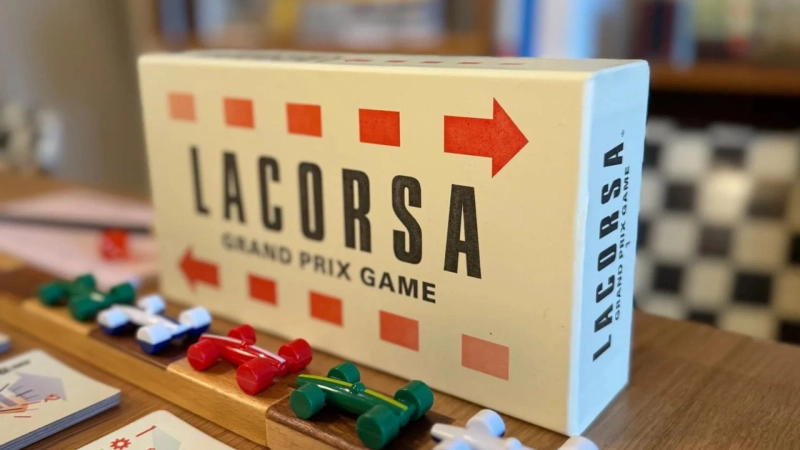Board racing games aren’t fading away. They’re becoming sharper, faster, and more layered. In an era when so much is digital, these games remain strong—and are even gaining speed.
Many fans are now seeking more depth. More tension. More strategy. That’s where games like the Lacorsa Game for Adults truly stand out. Let’s explore what’s fueling this rise—and why it’s far from slowing down.
1. They Bring Real Race Strategy to the Table
Modern racing games aren’t just about who rolls the highest; they incorporate real mechanics. Consider pit stops, crashes, track characteristics, and team strategy.
Players start to analyze the "race" as a team principal might. They consider risk, track position, and pace.
It’s no longer simply luck; it’s strategy, understanding others, and anticipating moves in advance.
These games have evolved, mirroring real racing tactics more closely than ever before.
2. They Tap Into a Niche That Craves Control
Video games offer players a quick thrill. However, board racing games provide complete control. Nothing is hidden under the hood. There’s no concealed code. Every number and move is available for everyone to see.
This appeals to players who seek more agency. They don’t desire flash; they want detail, and they want their decisions to feel significant.
Every move in a racing board game carries weight. There’s no cushion. No patch. Just you and the grid.
3. They Reward Timing Over Speed
Not all races favor the fastest car. This holds on real tracks as well as on the game board. Racing board games teach the importance of holding back, waiting for others to burn out, and saving up for that one decisive overtake in the final lap.
They challenge the notion that the first to move wins. This alone keeps things tense. The surprise isn’t who has the fastest start; it’s who plays smart at the halfway mark.
4. They Bridge Motorsport and Tactics
Motorsport fans often enjoy more than just race day. They appreciate setups, team calls, track position, and pit stop timing. Racing board games provide all of that in miniature form.
Each track can have variations in performance, and every race presents challenges. Some circuits, like Monza, are fast with long straights for slipstreaming, whereas at Monaco, it's all about qualifying.
And the exciting part? You feel like a strategist, not just one of the drivers. That’s what keeps people coming back.
5. They’re Low-Tech But High Tension
You don’t need glowing screens to feel sweat on your brow. Board racing games often boil down to a single move: a failed pass, a bad pit stop, or scraping the barrier, all of which can cost your team the win.
That kind of pressure builds over time. It’s quiet but intense. You can’t fast-forward; you live in each moment.
And once it’s done, players often sit back, breathe deep, and say, “Let’s go again.”
6. They Work for Themed Nights and Events
Most board games are challenging to shape into events. Not racing games. You can run an entire season in one night. People dress up in team shirts. They offer food that reflects the global significance of Grand Prix racing. Some even bring Champagne.
Themed nights have become a real thing. And racing games are something spectacular and unique.
They come with drama. With stakes. With easy rules for guests to jump in. A few laps later, everyone’s shouting like they’re trackside.
7. They Keep Getting Better, Not Just Prettier
Many modern games lean on looks. Racing games bring mechanics to match. Designers now test new rule systems, incident charts, and weather charts. Every version feels more expansive than the last.
Fans notice. They share feedback. Makers are listening to how gamers and race fans want to compete.
That growth loop means racing board games aren’t stale, but moving forward. Smart fans notice the difference right away.
Conclusion: Where the Thrill Stays Real
Board racing games aren’t just hanging on—they’re evolving. They offer players a rush that isn’t based on flashing lights or fast cuts. It's a slow burn, high pay-off, and deep focus.
Fans of motorsport feel seen. They aren’t just handed sleek machines; they’re handed tools, strategy, and choice.
One game that stands out right now is the Lacorsa Grand Prix Board Game. Lacorsa wasn’t created in a lab or churned out by a studio; it was born out of love for racing. Mark Haskins built it not for gaming trends, but for bringing authentic racing home.
The grip of the game comes from its rhythm. You try one strategy and then realize someone has blocked your line. You adjust. You take a risk. Maybe it pays off; maybe it doesn’t.
That’s the magic of Lacorsa. It’s not just about winning; it’s about reading the situation—and the competition. It’s about timing that one final burst just right.
Lacorsa creates moments—ones that stick, ones where silence falls before a dice roll, and where laughter follows a bold pass. Where players look at each other and say, “Let’s do that again.”
Lacorsa Game for Adults proves that smart, simple design still works, that speed can live on a table, and that good games don’t fade—they evolve.



